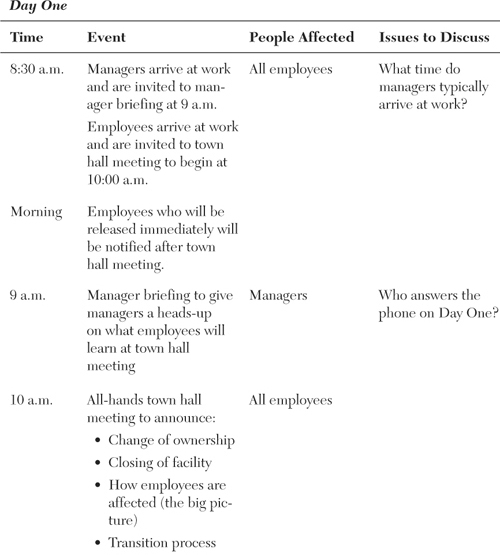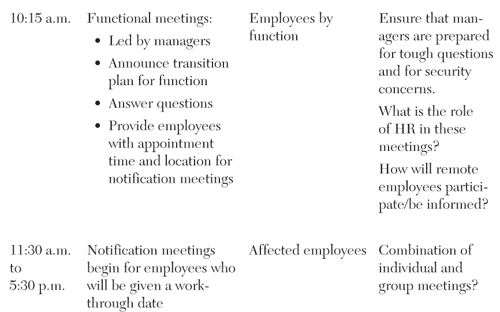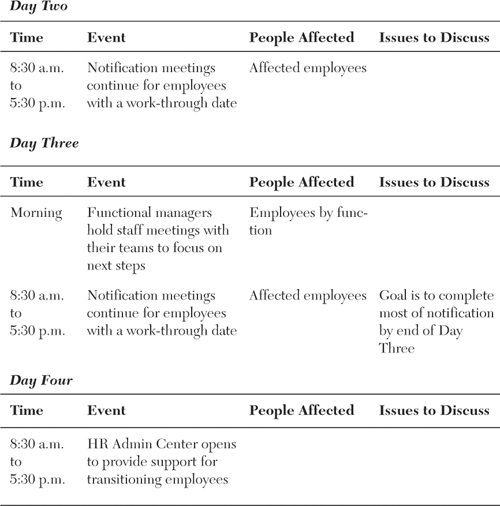17. Leaving the Company
“You Say Good-bye, and I Say Hello”
And now we come to the end—of your relationship with your employee. We’re devoting this final chapter to communicating departures—from a resignation to a firing to a layoff.
As always, our focus is on how to communicate, not on the legal, financial, and logistical aspects of separation. (Quite a few books have been written about those topics, including Employee Termination Source Book by Wendy Bliss and Gene Thornton, available from the Society of Human Resources.)
Here’s a key point to remember: Although it’s natural to focus on the person who’s leaving, it’s critical to spend just as much time and energy communicating with those who remain. After all, you want those employees to come to work tomorrow with a clear head and a positive attitude. You don’t want them to be weighed down because of how a colleague’s departure was handled.
In this chapter, we provide communication tips to help you deal with three ways employees leave: resignation, firing for cause, and layoffs (also known as a reduction in force).
“Good News: I’m Resigning”
It’s a sad day when a valued employee hands in her resignation. Even if the departing employee was not a star performer, a resignation brings unwelcome disruption. How will the employee’s work get done in the short term? How will you find someone to take her place? What impact will the employee’s departure have on the people she worked with?
As a result, it’s not uncommon for people to feel angry that the resigning employee is “deserting us.” And it’s also not unusual for the employee’s manager, HR, leaders, and colleagues to act out—to suddenly be cold, distant, and even mean.
This is not only juvenile, it’s also shortsighted. Even though the employee is leaving (for what she believes are good reasons), the relationship continues, especially in the social-networked small world in which we live. A resignation is actually an opportunity—a chance to influence the soon-to-be ex-employee to have a positive attitude about her soon-to-be former employer. If the transition is managed well, the potential exists for the employee to do the following:
• Say positive things about the company’s products or services
• Recommend her former company to potential employees as a good place to work
• Become a client
• Return someday to become an employee again, bringing the valuable skills she learned while she was away
So how do you handle a resignation in a positive way? Since these events are usually a surprise, we recommend that you prepare in advance by creating a Guide to Successful Resignations. Provide the guide to managers, either ahead of time (as part of a manager’s tool kit) or immediately after an employee tenders her resignation. This guide obviously needs to align with and support your HR policies. Here’s a sample of what this manager’s guide might include:

We Regret to Inform You . . .
Sometimes an employee just doesn’t work out. Maybe the company or department isn’t the right fit for that person. Or the employee doesn’t have the right skills to do the job. Or the employee’s attitude or approach creates constant problems. Whatever the reason, the employee’s manager, with the support of HR, has decided that the situation can’t be improved, so it’s time to let the person go.
Even though firing the employee is the best decision for the company (and maybe, eventually, for the employee), it’s difficult and painful. Still, it’s important to handle the firing well, not just for legal reasons (no doubt you’ve consulted your attorney), but also because
• It’s the right thing to do.
• Doing the right thing sends a strong signal to other employees that, even when things don’t work out, the company still treats people with dignity and respect.
Quiet Communication
Communicating a firing should be as calm and quiet as possible:
• When you’re ready (with all your documentation and the severance arrangement), have a conversation with the employee, preferably in a neutral location such as a conference room. Some companies require that an HR manager be present, along with the employee’s manager. In any case, calmly explain to the employee why he is being fired. This is not the time for long explanations, just a summary of why the relationship is ending. The employee may want to talk or express anger or frustration. It’s your job to listen for as long as the employee needs. Although feelings may be running high, try to end on a positive note, wishing the employee well.
• During the meeting, be clear about what happens next. Your policy may require an employee to leave the workplace immediately, or you may give the employee a day or two to get his stuff organized. Let him know how coworkers and others will be informed of his departure.
• After the employee leaves, or as he prepares to leave, communicate with others on his team or in his function. At Alison’s company, we prefer a face-to-face meeting so that employees can hear the news straight from the boss. At other companies, especially those with remote employees, e-mail is used to get the news out quickly. Either way, you need to be brief, since you can’t go into too many details. But we believe you should make it clear that this person was fired because he didn’t work out, not because you were trying to cut costs. It’s actually a positive thing when employees understand that your company will fire someone for poor performance: It sends a signal that your expectations are high, and that you won’t let someone struggle who can’t make a meaningful contribution.
“Let’s Focus on What Happens Next”
One of the best tactics we’ve seen in the manager/employee discussion where an employee is being fired is when the manager moves quickly to focus on what happens next rather than dwelling on what went wrong.
Here’s what this sounds like:
“Tom, I’m sorry that your job here isn’t working out in a way that’s good for either you or the company, so we’ve decided to end your employment. You’ve been struggling with [name one or two job criteria].
“In this meeting, I’d like to focus on what happens next. You’ll be paid through [date] and you’ll receive xx weeks of severance pay, either in a lump sum or on regular paydays. If you take a lump-sum payment, your insurance coverage would stop immediately, so you may want to continue receiving your regular pay. You’re eligible for outplacement counseling, which means you’ll get help in finding your next job . . . .”
This tactic helps focus any discussion on what happens next rather than an argument about what went wrong, which won’t end happily for anyone involved.
The Worst Day Ever: Layoffs
It’s sad but true that at many companies, layoffs have become a way of life. According to the consulting firm Accenture, 65% of U.S. companies reduced their number of full-time employees in 2009, and 63% of global companies did so.
But just because layoffs are commonplace doesn’t mean they’re easy. In fact, we find that they get more difficult every time, because they have a negative effect on morale.
We won’t debate whether laying off people to cut costs is the right decision (although we will mention that one school of thought says that layoffs cause more productivity harm than financial good). We will tell you that there’s a right way and a wrong way to communicate layoffs. We’ll give you advice on how to do it right.
Experience Tells Us
Unfortunately, we’ve communicated enough layoffs that we’ve developed a tried-and-true approach for doing so. Here are the key strategies we find work well:
• Use face-to-face communication to deliver decisions that have a personal impact.
• Provide key leaders, including facility and functional leaders, with the support they need to be visible and effective.
• Prepare HR staff and managers to deliver communication.
• Develop print and online vehicles to deliver detailed information and reinforce changes.
• Consistently measure results and adjust your plans.
You Need a Plan
As a first step, you need a plan. Effective layoffs require split-second timing, because you have many moving parts to manage. So you need to make sure you’ve mapped out all the things you need to do. The following is the first draft of a plan we created for a company that was making an acquisition. The company planned to announce large-scale layoffs to close a major facility as soon as the deal closed. We used the following timeline as a discussion document to work through issues and develop a more detailed plan:
Before Day One
Selected executives/employees may be notified and immediately released.

Supporting Leaders Through the Layoff
Who decides to lay off employees? In almost every case, company leaders—and they’re often the ones who decide who will be let go. But just because leaders are very involved in planning the layoff doesn’t mean they’re ready to communicate. That’s why we recommend holding a briefing session to do the following:
• Help leaders understand their communication role, and prepare them to fulfill that role.
• Make sure they agree on key messages.
• Give leaders a chance to practice delivering those messages.
• Talk through potential situations that may occur.
• Vent about their emotions concerning the layoff. (After all, leaders feel bad too, and they need to work through how they feel so that they can get past it and focus on employees’ needs.)
Managers Need the Most Help
Although leaders are responsible for communicating the big picture, it’s managers who are usually on the front lines of a layoff. Even if managers are not delivering the bad news, they’re the ones who have to deal with the aftermath of depressed departing employees and disgruntled survivors.
In our minds, there’s no such thing as overpreparing managers for an upcoming layoff. In fact, we find that the more time you can invest in managers, the more invested managers feel in the change—and the more prepared they are to help employees through it.
A Case for FAQs
In Chapter 8, “Make Meetings Meaningful—and Support Managers,” we mention the importance of frequently asked questions as one of the most valuable tools to help managers communicate. When it comes to a layoff, we find that FAQs are a must—particularly for managers, but also for HR and leaders. Creating a FAQ document helps you work through all the issues involved in a layoff and helps you decide how you will handle these issues.
The key to developing an effective FAQ document is to brainstorm every tough question a manager or employee would ask, and then create a straightforward answer for each question. FAQs may then be used for leader and manager briefings, but we don’t recommend that they be shared with employees directly. FAQs help prepare managers (who want to feel confident that they know the answer to every possible question), but they overwhelm departing employees. If you want to create information to give employees, develop a summary document that spells out the terms of the separation. This approach is consistent with what we advocate for communicating any policy or benefit: Give employees an easy-to-read and easy-to-understand print piece that they can share with family and that will help them make good decisions.
Give Managers a Chance to Practice
The most effective way to prepare managers for an upcoming layoff is to hold a training session so managers get a chance to rehearse what they need to do. A key element of this practice is to deal with potential scenarios they might encounter during the course of the layoff period.
For example, the following are some scenarios we created for the company that was closing a facility after an acquisition. Employees were to be given notice and then continue working for 30 to 60 days to support the transition. We created scenarios that managers might encounter during this transition, and we gave them a chance to come up with potential solutions. If they got stuck, the session leader would help them develop strategies for managing these tough situations:
• An employee is disrupting the work environment with repeated outbursts. This individual complains to everyone about losing his job and expresses fears about finding future employment.
• Your team members seem confused about what they need to do. Some spend their time focusing on things that aren’t important. Critical tasks aren’t being completed.
• You can’t get anyone to talk during your team meetings. Everyone has a stony look and won’t join the conversation.
• Anytime you ask a particular team member to complete a task, he assures you he’ll do it. But you’ve come to realize that he never follows through on your requests, and his work isn’t getting done.
• The former manager of your group asks you a series of tough questions, and you’re unsure of the best way to respond. You’re concerned that the answers to some of her questions are tough to hear and won’t be well received. In addition, there’s one question you don’t have an answer for, but you don’t want her to think you’re not in the loop.
Checklist for Communicating as Employees Leave the Company
![]() Create communication plans for employees who are leaving, as well as those who are staying.
Create communication plans for employees who are leaving, as well as those who are staying.
![]() Share bad news in person. Focus on what will happen next and what transition help employees will receive.
Share bad news in person. Focus on what will happen next and what transition help employees will receive.
![]() Encourage managers and executives to thank departing employees for their contributions, and treat these employees with dignity and respect.
Encourage managers and executives to thank departing employees for their contributions, and treat these employees with dignity and respect.
![]() Prepare managers to handle transitions effectively through training, practice sessions, and coaching, and then give them “just in time” FAQ documents.
Prepare managers to handle transitions effectively through training, practice sessions, and coaching, and then give them “just in time” FAQ documents.
![]() Create a communications plan as a chart showing who will learn what, when, and how.
Create a communications plan as a chart showing who will learn what, when, and how.
![]() Remember that endings are always opportunities for new beginnings. (We wanted our last bit of advice in this book to be cheerful. Thanks for reading. We wish you good luck with all your human resources communications, from recruiting to leaving the company.)
Remember that endings are always opportunities for new beginnings. (We wanted our last bit of advice in this book to be cheerful. Thanks for reading. We wish you good luck with all your human resources communications, from recruiting to leaving the company.)


